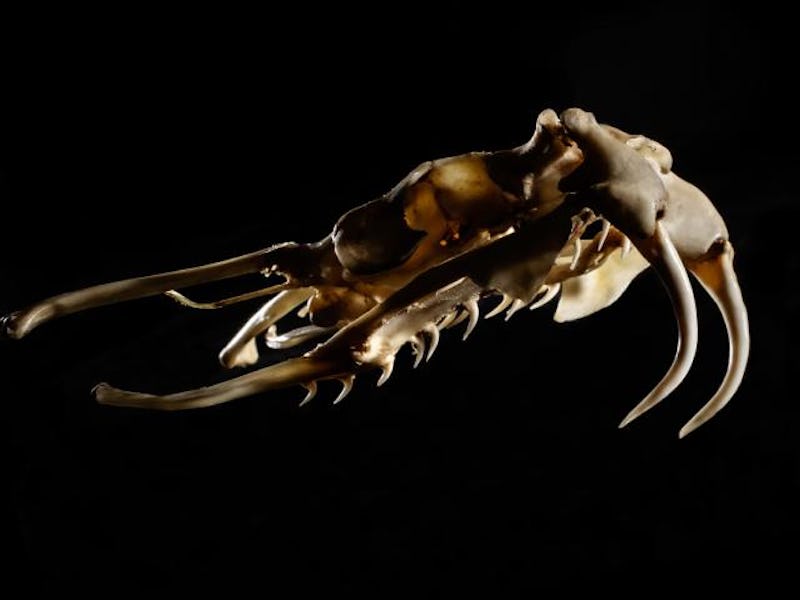Viper Fangs Reveal How Evolution Perfected the Art of Puncturing
"Puncture is actually something that transcends the organism."

At an early age, we realize that sharp things hurt. Rose thorns, cactus spines, dog teeth, and fish bones all share the ability to puncture our delicate skin, causing pain and, often, a bloody mess. Unfortunately, they’re hard to avoid. Nature’s puncturing tools are staggeringly ubiquitous, and a new paper in Biology Letters reveals how some are so much sharper than others by examining the sharpest ones around: viper fangs.
"Puncture is actually something that transcends the organism."
The paper, published Tuesday, was born out of the Anderson Lab at the University of Illinois at Urbana-Champaign, which is dedicated to the study of nature’s vast range of sharp objects. By studying how the laws of physics shaped the evolution of these tools, they hope to shed light on why every major group of organisms has developed the ability to puncture flesh.
Vipers, like Trimeresurus vogeli here, have some of nature's sharpest puncturing tools.
Viper fangs were the perfect place to start, says first author and lab leader Philip Anderson, Ph.D., because the “charismatic” animals are already so well studied. By understanding how evolution shaped sharpness we can make human tools better — and perhaps create materials that are puncture-proof, he explains to Inverse.
A viper fang, he says, “has one job to do, which is to puncture and inject venom.” Co-author and postdoctoral researcher Stephanie Crofts, Ph.D. puts it this way: “That’s more or less what evolution has shaped them to do.”
We intuitively know what is sharp and what is not, but on a morphological level it’s much less obvious. Crofts and Anderson had to break it down by asking one fundamental question:
What Makes a Sharp Thing Sharp?
An electron micrograph of a common lancehead fang (Bothrops atrox). Fangs with a narrow tip angle are the sharpest.
The team turned to an extensive collection of 28 viper fangs at the Field Museum in Chicago and looked closely at their characteristics. To do their job well, viper fangs must be able to quickly pierce flesh then withdraw just as rapidly, so tip shape and smoothness are paramount. The angle of the fang tips, their roundedness, and their surface area all seemed to play a role in their ability to puncture, which the team measured by mounting each fang to a machine that would jab at a cube of ballistics gel.
A team of mechanical engineers experimented in parallel, using metal punches with similar features to the fangs to isolate the characteristics that made for the best puncture.
Tip angle, they determined, was everything. “The narrowness of the tip angle is what’s really important,” Crofts said. The narrowness of a fang also came into play, as did the roundedness of its tip, but not nearly as much.
“Taking a look at their shape and trying to understand what aspects of that shape correlate to their function was a really important first step for everything else that’s going to come after,” Crofts adds.
Transcending the Organism
The lab has big plans to lay out “what the baseline rules are” for puncture, says Anderson. In the same way that biologists fundamentally understand that, say, marine mammals can be bigger than terrestrial ones because the water supports their extra weight, they hope to understand how and why puncturing tools developed so well in certain organisms.
Perhaps we will follow those rules someday, developing synthetic needles that are so narrow-tipped and fine they don’t hurt when we receive a vaccine. Stings from the dreaded Portuguese man o’war, Anderson points out, only hurt because of the venom — the stinger itself is too small to be picked up by the nervous system.
In the water, the Portuguese man o'war delivers a painful sting — but the stinger itself isn't what causes the pain.
Though humans tend to focus on their synonymity with violence, puncturing tools actually play a number of roles in nature, he adds. Cactus spines can serve as shade from the desert sun; animal teeth can be used for gripping, play-fighting, and competition; some thistles spread their seeds through prickles that latch on to passing animals.
"I’m predisposed to thinking anatomy is beautiful in general."
“Puncture is actually something that transcends the organism,” says Anderson. “In almost any sort of major group of organisms — animals, plant, and whatnot — you find examples of puncture.”
In previous research, he has studied the destructive forelimbs of the fast-punching mantis shrimp, the prickles of cactus spines — and the tough hides of the wild pigs who are immune to them. Croft notes that insect stingers and jellyfish stings are all capable of puncturing tissue, noting that the stingray has especially “beautiful stings” on the back of their tails. “They almost look like sculptures.”
Aware that research focused strictly on puncture may seem a little “myopic,” Crofts concludes, “I’m an organismal biologist, so I’m predisposed to thinking anatomy is beautiful in general.”